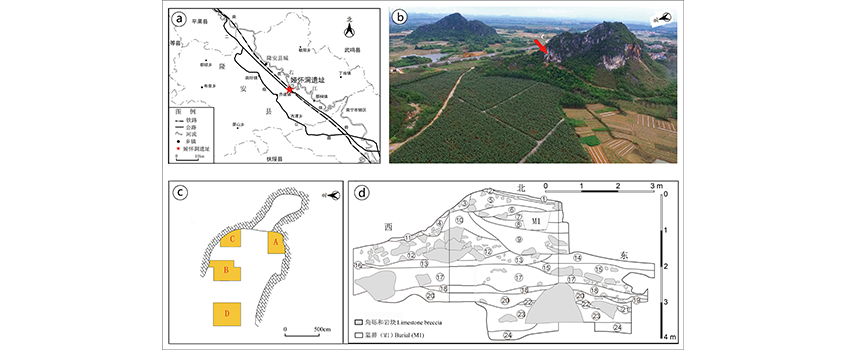

An excavation report of the Yahuai Cave site in Long’an, Guangxi
Received date: 2024-10-18
Revised date: 2025-05-10
Online published: 2025-06-18
The Yahuai Cave site is situated at a limestone tower near Bolang Village, Long’an County, Guangxi Zhuang Autonomous Region, South China (107°45′35″E, 23°6′25″N). It is a prehistoric site predominantly characterized by Palaeolithic deposits. Between 2015 and 2018, the Guangxi Institute of Cultural Relic Protection and Archaeology carried out excavations at this site. Four areas, namely A, B, C, and D, were opened, with a total exposure area of 50 m². A burial containing a complete Palaeolithic human skull was discovered. A multitude of cultural remains, such as chipped stone tools, ground stone tools, shell and bone artifacts, and potsherds, were unearthed. The majority of the stone tools are made of small quartz sandstone, tektite, chert, or crystal stones, exhibiting features typical of the “core-flake industry” commonly found in North China. Three hearths and an ash pit were identified, suggesting frequent fire usage at the site. Ochres were found throughout all cultural layers, and some of them were discovered to be ground into powder. Numerous bones of terrestrial and aquatic animals were excavated. The site was dated using the AMS 14C dating method to a period between 43,000 and 4,000 BP cal. Four cultural phases were recognized, with phases 1~3 belonging to the Palaeolithic period and phase 4 to the Neolithic period.

Key words: Yahuai Cave site; human skull; stone artifacts; Late Paleolithic
XIE Guangmao , LIN Qiang , YU Minghui , LU Jieying . An excavation report of the Yahuai Cave site in Long’an, Guangxi[J]. Acta Anthropologica Sinica, 2025 , 44(03) : 365 -388 . DOI: 10.16359/j.1000-3193/AAS.2025.0046
| [1] | Matsumura H, Xie G, Nguyen LC, et al. Female craniometrics support the two-laye model of human dispersal in Eastern Eurasia[J]. Scientific Reports, 2021, 11: 20830 |
| [2] | Toth N. The oldowan reassessed: A close look at early stone artifacts[J]. Journal of Archaeological Science, 1985, 12(2): 101-120 |
| [3] | 宋艳波, 谢光茂, 赵文丫. 广西隆安娅怀洞遗址出土动物遗存初步研究[J]. 第四纪研究, 2020, 40(2): 343-353 |
| [4] | Wu Y, Xie G, Mao L, et all. Phytolith evidence for human-plant subsistence in Yahuai Cave (Guangxi, South China) over the past 30000 years[J]. Science China Earth Sciences, 2020, 63: 1745-1757 |
| [5] | 广西柳州白莲洞洞穴科学博物馆, 等. 广西柳州白莲洞石器时代洞穴遗址发掘报告[C]. 南方民族考古, 1987, 1: 143-160 |
| [6] | 广西柳州白莲洞洞穴科学博物馆. 柳州白莲洞[M]. 北京: 科学出版社, 2009 |
| [7] | 蒋远金, 叶亮, 李刚. 浅析白莲洞遗址的石器工业[J]. 史前研究, 2009, 1: 145-153 |
| [8] | 贵州省文物考古研究所. 贵州开阳打儿窝岩厦遗址试掘简报[C]. 长江文明, 2013, 11: 1-19 |
| [9] | 关莹, 蔡回阳, 王晓敏, 等. 贵州毕节老鸦洞遗址2013年发掘报告[J]. 人类学学报, 2015, 34(4): 461-478 |
| [10] | 湖南省文物考古研究所,石门县博物馆. 石门燕耳洞旧石器遗址试掘[C]. 湖南考古辑刊, 1994, 6: 1-7 |
| [11] | 袁家荣. 湖南旧石器时代文化与玉蟾岩遗址[M]. 长沙: 岳麓书社, 2013 |
| [12] | 彭适凡, 周广明. 江西万年仙人洞与吊桶环遗址[J]. 农业考古, 2004, 3: 29-39 |
| [13] | 王幼平. 华南晚更新世晚期人类行为复杂化的个案—江西万年吊桶环遗址的发现[J]. 人类学学报, 2016, 35(3): 397-406 |
| [14] | Quang VC. Archaeological discoveries and study in Thanh Sa Valley and the problem of the Nguom industry[J]. Vietnam Archaeology, 1995, 1: 3-17 |
| [15] | Hoang XC, Nguyen KS. Vietnam stone age[A]. In: Van Tan H, Ha E(eds). Vietnam Archaeology[C]. Social science publishing house, Hanoi, 1998, 70-85 |
| [16] | Nguyen K. Stone age archaeology in Vietnam[J]. Vietnam Archaeology, 2007, 2: 53-64 |
| [17] | Anderson DD. Lang Rongrien Rockshelter:a Pleistocene, Early Holocene archaeological site from Krabi, Southwestern Thailand [M]. Philadelphia:University Museum Monograph, The University Museum, 1990, 71 |
| [18] | Anderson DD. Cave archaeology in Southeast Asia[J]. Geoarchaeology: An International Journal, 1997, 12(6): 607-638 |
| [19] | 中国社会科学院考古研究所华南一队, 等. 贵州贵安新区牛坡洞遗址[J]. 考古, 2017, 7: 3-17 |
| [20] | 李意愿. 湖南澧县彭头山遗址燧石石制品的技术、功能与相关问题[J]. 江汉考古, 2017, 6: 42-51 |
| [21] | 柳州市博物馆, 等. 柳州市大龙潭鲤鱼咀新石器时代贝丘遗址[J]. 考古, 1983, 9: 769-774 |
| [22] | 中国社会科学院考古研究所广西工作队, 等. 广西邕宁县顶狮山遗址的发掘[J]. 考古, 1998, 11: 11-33 |
| [23] | 王幼平. 砾石工业传统与华南旧石器晚期文化[J]. 南方文物, 2021, 1: 94-95 |
| [24] | Xie GM, Lin Q, Wu Y, et al. The Late Paleolithic industries of southern China (Lingnan region)[J]. Quaternary International, 2020, 535: 21-28 |
/
| 〈 |
|
〉 |